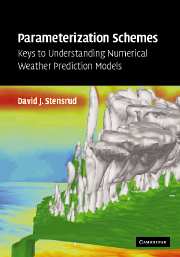Book contents
- Frontmatter
- Contents
- Preface
- List of principal symbols and abbreviations
- 1 Why study parameterization schemes?
- 2 Land surface–atmosphere parameterizations
- 3 Soil–vegetation–atmosphere parameterizations
- 4 Water–atmosphere parameterizations
- 5 Planetary boundary layer and turbulence parameterizations
- 6 Convective parameterizations
- 7 Microphysics parameterizations
- 8 Radiation parameterizations
- 9 Cloud cover and cloudy-sky radiation parameterizations
- 10 Orographic drag parameterizations
- 11 Thoughts on the future
- References
- Index
11 - Thoughts on the future
Published online by Cambridge University Press: 05 September 2013
- Frontmatter
- Contents
- Preface
- List of principal symbols and abbreviations
- 1 Why study parameterization schemes?
- 2 Land surface–atmosphere parameterizations
- 3 Soil–vegetation–atmosphere parameterizations
- 4 Water–atmosphere parameterizations
- 5 Planetary boundary layer and turbulence parameterizations
- 6 Convective parameterizations
- 7 Microphysics parameterizations
- 8 Radiation parameterizations
- 9 Cloud cover and cloudy-sky radiation parameterizations
- 10 Orographic drag parameterizations
- 11 Thoughts on the future
- References
- Index
Summary
Introduction
Throughout the previous chapters we have examined a number of the most commonly used types of parameterization schemes within numerical weather prediction models. While individual parameterization schemes are constantly undergoing revision and new schemes appear in both the literature and operational models routinely, the underlying need for the parameterization of fundamental atmospheric processes has not changed. Indeed, the number of processes that are being parameterized has increased over the past 20 years to allow for more realism in both forecasts and climate simulations. These additional parameterizations may not be crucial to the model forecasts at all times and places, but they can make a significant difference regarding a particular event of importance to a specific user or community.
This evolution of parameterization highlights the fact that numerical models are becoming more capable (see Roebber et al. 2004). Models now can reproduce many of the phenomena that are observed in the atmosphere. As simple examples, moderate- and high-resolution models of today can reproduce mesoscale convective systems with their leading line of deep convection and trailing stratiform precipitation region as well as sea breezes and mountain-valley flows, while coupled ocean–atmosphere models can reproduce El Niño–Southern Oscillation (ENSO) events. These phenomena could not be reproduced by any of the operational models (or even many research models) in use back in the 1970s, owing in part to their large grid spacing and in part to the parameterization schemes in use.
- Type
- Chapter
- Information
- Parameterization SchemesKeys to Understanding Numerical Weather Prediction Models, pp. 393 - 407Publisher: Cambridge University PressPrint publication year: 2007



